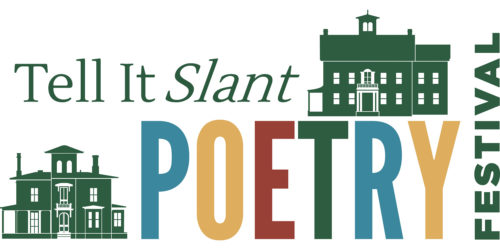
That’s a wrap on 2024 Tell It Slant Poetry Festival, we hope to see you next year. Sign-up for our e-newsletter to be the first to know!
The Tell It Slant Poetry Festival returns September 23 – 29, 2024!
Join us for a week of events happening both online and in-person at the Museum.
The Emily Dickinson Museum’s annual Tell It Slant Poetry Festival is an event with international reach that celebrates Emily Dickinson’s poetic legacy and the contemporary creativity she and her work continues to inspire from the place she called home.
This year’s FREE and hybrid Festival includes events happening online, as well as in-person at the Museum under our heated tent.
This year’s line-up features a talented group of poets from around the country including readings by Pulitzer Prize winners Carl Phillips (2023) and Diane Seuss (2022), generative writing workshops, poetry panels, a masterclass with celebrated poet Oliver de la Paz, a musical theater performance by the Wilde Irish Women exploring Dickinson’s relationship to her Irish maid Margaret Maher, and more. The cornerstone of the Festival, the Emily Dickinson Poetry Marathon, is an epic reading of all 1,789 of Emily Dickinson’s poems across the Festival week. Learn more about the 2024 lineup below.
THE SCHEDULE:
Monday, September 23:
6-8:30pm [Virtual] — Emily Dickinson Poetry Marathon: Part 1
A group reading of all 1,789 poems by Emily Dickinson over the course of 7 sessions. This session takes place entirely virtually and is open to both readers and listeners. We will be reading from Ralph Franklin’s The Poems of Emily Dickinson: Reading Edition. Sign up as a listener by registering for the Festival, or learn more about signing up as a reader!
Tuesday, September 24:
12-2:15pm [Virtual] — Emily Dickinson Poetry Marathon: Part 2
A group reading of all 1,789 poems by Emily Dickinson over the course of 7 sessions. This session takes place entirely virtually and is open to both readers and listeners. We will be reading from Ralph Franklin’s The Poems of Emily Dickinson: Reading Edition. Sign up as a listener by registering for the Festival, or learn more about signing up as a reader!
6-7pm [Virtual] — Our Roots as Muse: Family & Ancestry as Creative Inspiration [SOLD OUT & RESCEDULED! Registrants have been invited to join us on Monday, October 14]
Facilitators will lead participants in a series of generative writing exercises using personal family and ancestral history as creative inspiration and content. Participants will leave the workshop with at least two writing sketches and other writing resources to continue developing their ideas and creatively archiving their own family histories.
Featuring .CHISARAOKWI. and Tamara J. Madison.
6:30-8pm [Virtual] — Telling our Medical Stories Slant [SOLD OUT!]
In this workshop, participants will learn how to translate their personal stories of illness and disability into poetry, something Dickinson herself practiced, and something that’s employed by practitioners of Narrative/Poetic Medicine.
Featuring Rosemarie Dombrowski and Catharine Clark-Sayles.
Wednesday, September 25:
12-2:15pm [Virtual] — Emily Dickinson Poetry Marathon: Part 3
A group reading of all 1,789 poems by Emily Dickinson over the course of 7 sessions. This session takes place entirely virtually and is open to both readers and listeners. We will be reading from Ralph Franklin’s The Poems of Emily Dickinson: Reading Edition. Sign up as a listener by registering for the Festival, or learn more about signing up as a reader!
4:30-6pm [Virtual] — Poetry, Spirituality, and New Forms of Attention
Emily Dickinson’s poems interact with silence to open spaces of questioning, recognition, and keen attention to spiritual matters and questions of meaning. In this workshop, we’ll place our own poetry in the context of Dickinson’s poetry, offer a short guided meditation and generative prompts for participants to explore their own relation to silence, voice, and spiritual attention.
Featuring Rachel Zucker and Nadia Colburn.
7:30-9pm [Virtual] — “Bee! I’m expecting you”: Dialogues with the Non-Human
Emily Dickinson lived in a time of ecological change and painful civil conflict. Against this backdrop, Dickinson’s poems reach out to the world around her—the frog, the snake, the hummingbird, train, “slant of light,” even the “loaded gun,” addressing these others as companions, fellow witnesses. In this panel, poets explore both Dickinson’s and their own dialogues with the nonhuman.
Featuring Carolina Ebeid, Julia Guez, Anna V. Q. Ross, and Tess Taylor.
Thursday, September 26:
12-2:15pm [Virtual] — Emily Dickinson Poetry Marathon: Part 4
A group reading of all 1,789 poems by Emily Dickinson over the course of 7 sessions. This session takes place entirely virtually and is open to both readers and listeners. We will be reading from Ralph Franklin’s The Poems of Emily Dickinson: Reading Edition. Sign up as a listener by registering for the Festival, or learn more about signing up as a reader!
6-7:15pm [Virtual] — Phosphorescence Contemporary Poetry Reading
Festival edition of the Museum’s monthly poetry reading series. Hear from poets around the world as they read their work and discuss what poetry and Dickinson mean to them.
Featuring Jane Huffman, Molly Akin, and Diane Seuss.
Friday, September 27:
12-2:15pm [Virtual] — Emily Dickinson Poetry Marathon: Part 5
A group reading of all 1,789 poems by Emily Dickinson over the course of 7 sessions. This session takes place entirely virtually and is open to both readers and listeners. We will be reading from Ralph Franklin’s The Poems of Emily Dickinson: Reading Edition. Sign up as a listener by registering for the Festival, or learn more about signing up as a reader!
3-4:30pm [Hybrid] — Poetry Masterclass with Oliver de la Paz
This generative workshop, with the Poet Laureate of Worcester Oliver de la Paz, will attend to the possibilities of creating new work that is in-tune with a subject that haunts you. We will be looking at how to write and sustain work within a singular focus, obsession, or motif.
7-8:30pm [Hybrid] — Open Mic Night with Oliver de la Paz and Diannely Antigua
Bring your poems to Emily Dickinson’s garden! Readers will have 4 minutes each to make us feel “physically as if the top of [our] head[s] were taken off!” (Emily Dickinson to Thomas Wentworth Higginson, 16 August 1870) Featured poets Oliver de la Paz and Diannely Antigua will follow the open mic. Open mic sign-ups will be handled in advance via a Google Form, and selected readers will be notified. Submit to read by Wed., Sept. 11th.
Saturday, September 28:
9:30am-12pm[Hybrid] — Emily Dickinson Poetry Marathon: Part 6
A group reading of all 1,789 poems by Emily Dickinson over the course of 7 sessions. For this session, readers must be present on-site, but listeners are welcome both in-person and online. We will be reading from Ralph Franklin’s The Poems of Emily Dickinson: Reading Edition. Gingerbread cookies inspired by Dickinson’s own recipe will be served. Sign up as a listener by registering for the Festival, or learn more about signing up as a reader!
1-2:30pm [Hybrid] — Poets of the Public: New England Poet Laureates
Poets will share about their role as Poet Laureate in their respective communities, sharing information about the programming we each developed, and will discuss what it means to be a “Civic Poet” with a broad set of responsibilities and audiences while also maintaining one’s own personal writing practice.
Featuring Oliver de la Paz and Diannely Antigua.
3:30-5pm [Hybrid] — “I am afraid to own a Body”: Continuing Dickinson’s Legacy of Braving the Body
A discussion of Dickinson’s poems about the body and embodied experience, particularly her exploration into the often-contradictory needs between body and mind. A selection of contemporary poems by women and non-binary poets from Braving the Body who have been inspired by Dickinson’s work. Prompts will be provided for a generative writing exercise.
Featuring Jennifer Franklin, Pichchenda Bao and Nicole Callihan.
7-9pm [Hybrid] — Headliner Night and Garden Party with Carl Phillips and Sebastian Merrill
Join us in Emily Dickinson’s garden or virtually for a celebration of creativity and poetry! Our headlining poets, 2023 Pulitzer Prize recipient Carl Phillips and Sebastian Merrill, read from their work and discuss poetic practice and inspiration.
Sunday, September 29:
10-11:30am [Virtual] — “Picnic, Lightning”: Concision, Compression, & Brevity in the Very Short Poem [SOLD OUT!]
Emily Dickinson is one of the greatest masters of the short poem. In this workshop for writers at all stages in their practice, we’ll focus on the Very Short Poem, the highly pressurized lyric that casts off a resonance far bigger than its real estate.
Featuring Patrick Donnelly.
11:30am-1pm [Hybrid] — Margaret Maher and the Celtification of Emily Dickinson
Featuring the poems of Emily Dickinson with music and lyrics by Rosemary Caine. If the Irish can claim they saved civilization, then the Wilde Irish Women dare to claim that Margaret Maher saved Emily Dickinson’s poems. Experience the lauded musical play that reveals the unlikely story of a humble Irish maid’s influence on her reclusive mistress, Emily Dickinson. Margaret Maher defied Emily’s deathbed decree to burn her poems. Her brave, independent thinking and courageous action came from being born in Ireland, a country where poems are respected, not burned. But there is so much more to the story…
Featuring Rosie Caine and Wilde Irish Women.
2-4pm [Hybrid] — Emily Dickinson Poetry Marathon: Grand Finale
A group reading of all 1,789 poems by Emily Dickinson over the course of 7 sessions. For this session, readers must be present on-site, but listeners are welcome both in-person and online. We will read from Ralph Franklin’s The Poems of Emily Dickinson: Reading Edition. Stay to the end to enjoy a celebratory slice of coconut cake inspired by Dickinson’s own recipe. Sign up as a listener by registering for the Festival, or learn more about signing up as a reader!
About the Festival:
The Emily Dickinson Museum’s Annual Tell It Slant Poetry Festival is an event with international reach that celebrates Emily Dickinson’s poetic legacy and the contemporary creativity she and her work continues to inspire from the place she called home.
The Festival is named for Dickinson’s poem, “Tell all the truth but tell it slant,” underscoring the revolutionary power of poetry to shift our perspective and reveal new truths. Festival organizers are committed to featuring established and emerging poets who represent the diversity of the contemporary poetry landscape and to fostering community by placing poetry in the public sphere.
This year’s line-up features workshops, panels, and readings, by a diverse and talented group of poets from around the world. The cornerstone of the Festival, the Emily Dickinson Poetry Marathon, is an epic reading of all 1,789 of Emily Dickinson’s poems.
To follow along with the Emily Dickinson Poetry Marathon, get your copy of the Franklin edition from the Emily Dickinson Museum Shop.
The annual event attracts a diverse audience of Dickinson fans and poetry lovers, including students, educators, aspiring writers, and those who are new to poetry and literary events. Past Festival headliners have included Marilyn Nelson, Abigail Chabitnoy, Tracy K. Smith, Tiana Clark, Tess Taylor, Ada Limón, Jericho Brown, Franny Choi, Aimee Nezhukumatathil, Paisley Rekdal, Adrian Matejka, Kaveh Akbar, and Ocean Vuong.
Support The Tell It Slant Poetry Festival:
Admission to all Poetry Festival events is free–made possible by contributions from Museum supporters.
Please consider making a donation of any size during the registration process or anytime on the Museum’s website.








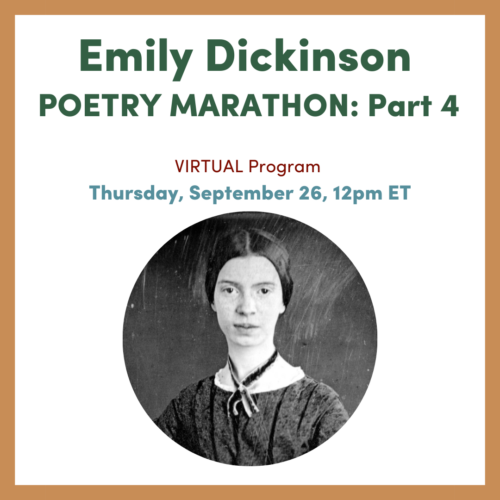










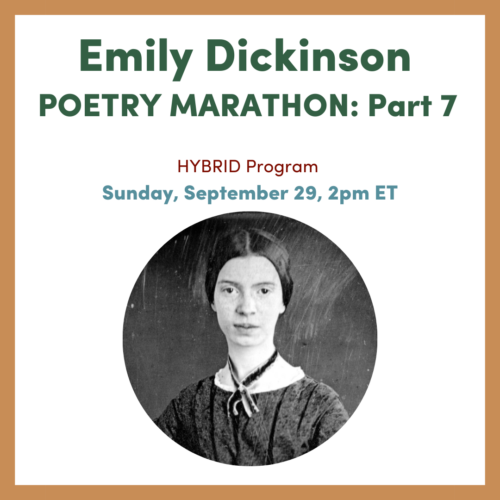
 The Emily Dickinson Museum (EDM) received a Sustaining Cultural Heritage Collections grant from the National Endowment for the Humanities to enhance environmental conditions renowned poet and her family. The largest and most varied collection of non-manuscript objects associated historically with the poet and her family had been stored since 1916 in The Evergreens, an Italianate two-story wood-frame house built by the Dickinson family in 1856.
The Emily Dickinson Museum (EDM) received a Sustaining Cultural Heritage Collections grant from the National Endowment for the Humanities to enhance environmental conditions renowned poet and her family. The largest and most varied collection of non-manuscript objects associated historically with the poet and her family had been stored since 1916 in The Evergreens, an Italianate two-story wood-frame house built by the Dickinson family in 1856.
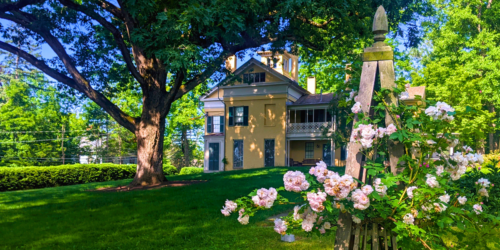
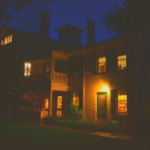

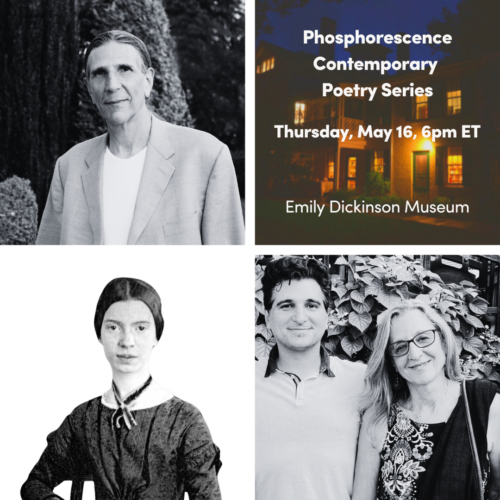 Thursday, May 16, 6pm ET
Thursday, May 16, 6pm ET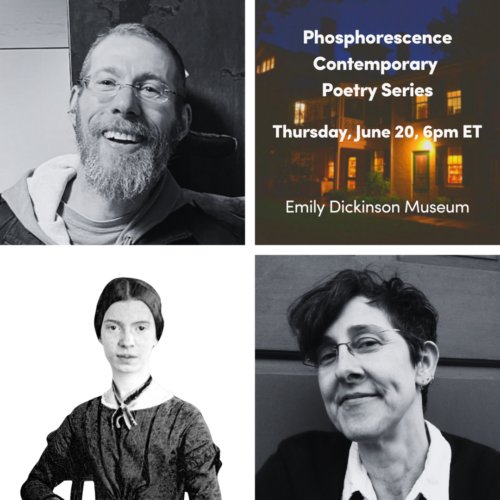 Thursday, June 20, 6pm ET
Thursday, June 20, 6pm ET Thursday, July 25, 6pm ET
Thursday, July 25, 6pm ET Thursday, August 15, 6pm ET
Thursday, August 15, 6pm ET Thursday, September 26, 6pm ET
Thursday, September 26, 6pm ET Thursday, October 17, 6pm ET
Thursday, October 17, 6pm ET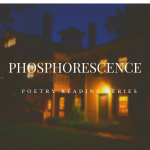


 Samyak Shertok’s debut collection, No Rhododendron, was selected by Kimiko Hahn for the 2024 AWP Donald Hall Prize for Poetry and is forthcoming from the University of Pittsburgh Press (Pitt Poetry Series) in 2025. His poems appear in The Cincinnati Review, The Gettysburg Review, The Iowa Review, The Kenyon Review, POETRY, Shenandoah, Best New Poets, and elsewhere. A finalist for the National Poetry Series, the Agnes Lynch Starrett Poetry Prize, and the Jake Adam York Prize, he has received fellowships from Aspen Words, the Helene Wurlitzer Foundation, and the Fine Arts Work Center in Provincetown. His work has been awarded the Robert and Adele Schiff Award for Poetry, the Gulf Coast Prize in Poetry, and the Auburn Witness Poetry Prize. Originally from Nepal, he was the inaugural Hughes Fellow in Poetry at Southern Methodist University and is currently an Assistant Professor of Creative Writing at Hendrix College.
Samyak Shertok’s debut collection, No Rhododendron, was selected by Kimiko Hahn for the 2024 AWP Donald Hall Prize for Poetry and is forthcoming from the University of Pittsburgh Press (Pitt Poetry Series) in 2025. His poems appear in The Cincinnati Review, The Gettysburg Review, The Iowa Review, The Kenyon Review, POETRY, Shenandoah, Best New Poets, and elsewhere. A finalist for the National Poetry Series, the Agnes Lynch Starrett Poetry Prize, and the Jake Adam York Prize, he has received fellowships from Aspen Words, the Helene Wurlitzer Foundation, and the Fine Arts Work Center in Provincetown. His work has been awarded the Robert and Adele Schiff Award for Poetry, the Gulf Coast Prize in Poetry, and the Auburn Witness Poetry Prize. Originally from Nepal, he was the inaugural Hughes Fellow in Poetry at Southern Methodist University and is currently an Assistant Professor of Creative Writing at Hendrix College.




 Joshua Jennifer Espinoza is a transsexual poet. Her work has been featured in Poetry Magazine, The American Poetry Review, Split Lip Magazine, Gulf Coast Journal, The Southeast Review, MoMA Magazine, and elsewhere. She is the author of I’m Alive / It Hurts / I Love It (2019) and THERE SHOULD BE FLOWERS (2016). She holds an MFA in poetry from UC Riverside and is currently a professor of creative writing. Jennifer lives in California with her wife, poet/essayist Eileen Elizabeth, and their cat and dog.
Joshua Jennifer Espinoza is a transsexual poet. Her work has been featured in Poetry Magazine, The American Poetry Review, Split Lip Magazine, Gulf Coast Journal, The Southeast Review, MoMA Magazine, and elsewhere. She is the author of I’m Alive / It Hurts / I Love It (2019) and THERE SHOULD BE FLOWERS (2016). She holds an MFA in poetry from UC Riverside and is currently a professor of creative writing. Jennifer lives in California with her wife, poet/essayist Eileen Elizabeth, and their cat and dog. 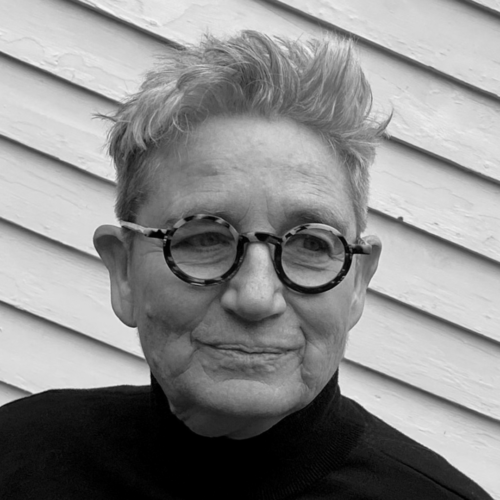




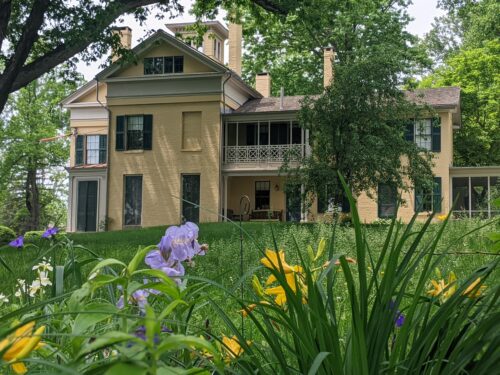
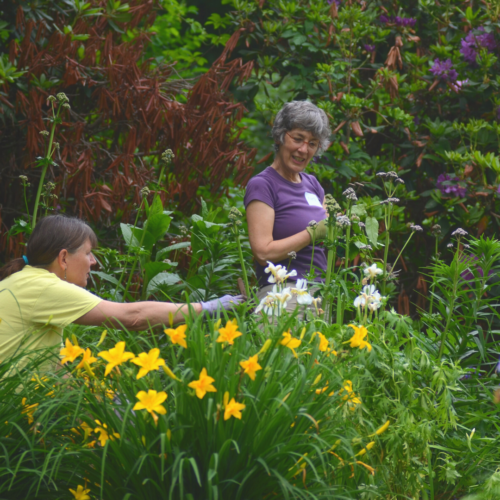 Marta McDowell teaches landscape history and horticulture at the New York Botanical Garden and is a popular lecturer and writer. Her latest book is Gardening Can Be Murder, about the horticultural connections to crime fiction. Timber Press also published Unearthing The Secret Garden, Emily Dickinson’s Gardening Life, The World of Laura Ingalls Wilder, New York Times-bestselling All the Presidents’ Gardens, and Beatrix Potter’s Gardening Life, now in its ninth printing. She was the 2019 recipient of the Garden Club of America’s Sarah Chapman Francis Medal for outstanding literary achievement.
Marta McDowell teaches landscape history and horticulture at the New York Botanical Garden and is a popular lecturer and writer. Her latest book is Gardening Can Be Murder, about the horticultural connections to crime fiction. Timber Press also published Unearthing The Secret Garden, Emily Dickinson’s Gardening Life, The World of Laura Ingalls Wilder, New York Times-bestselling All the Presidents’ Gardens, and Beatrix Potter’s Gardening Life, now in its ninth printing. She was the 2019 recipient of the Garden Club of America’s Sarah Chapman Francis Medal for outstanding literary achievement.